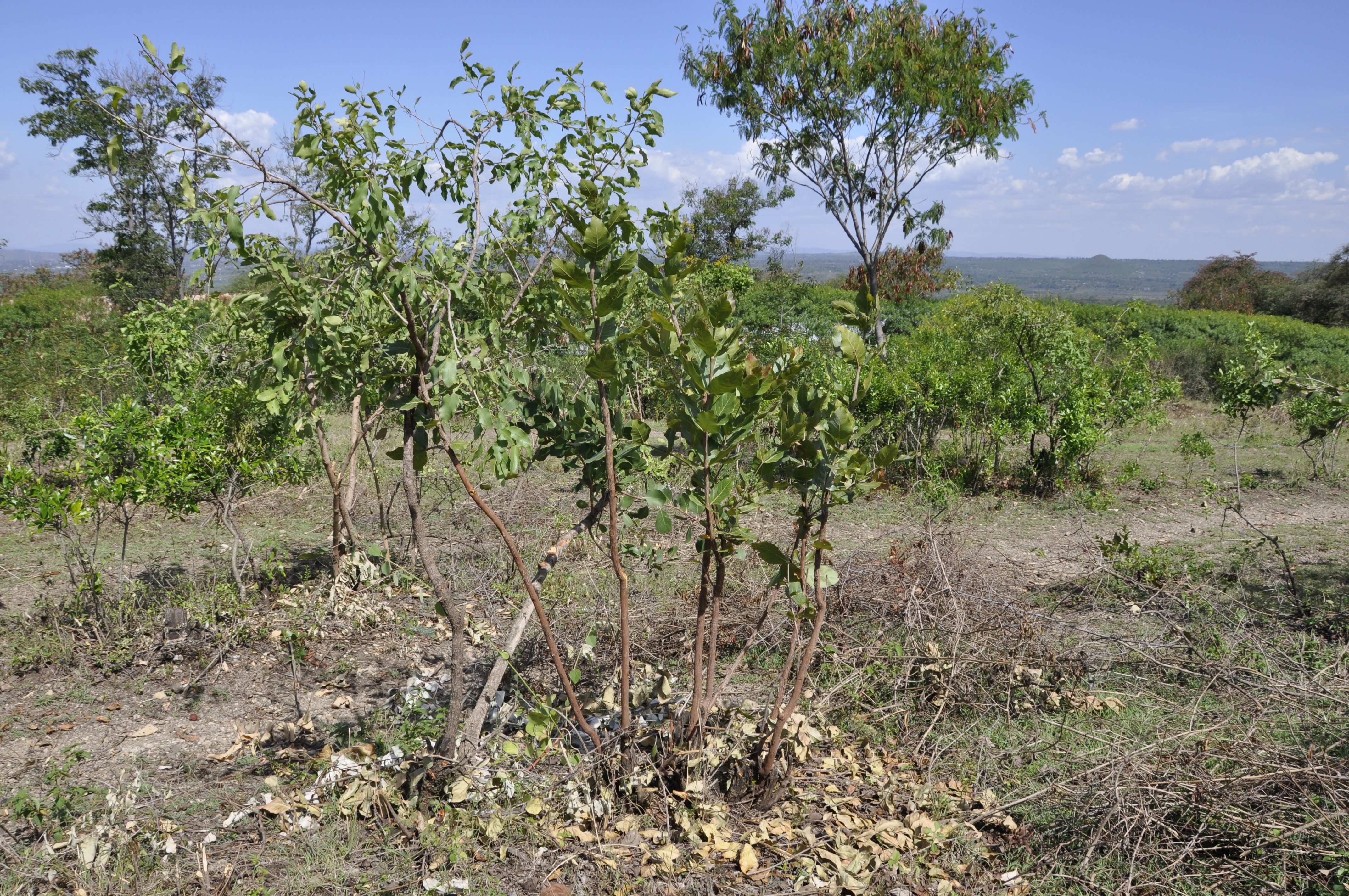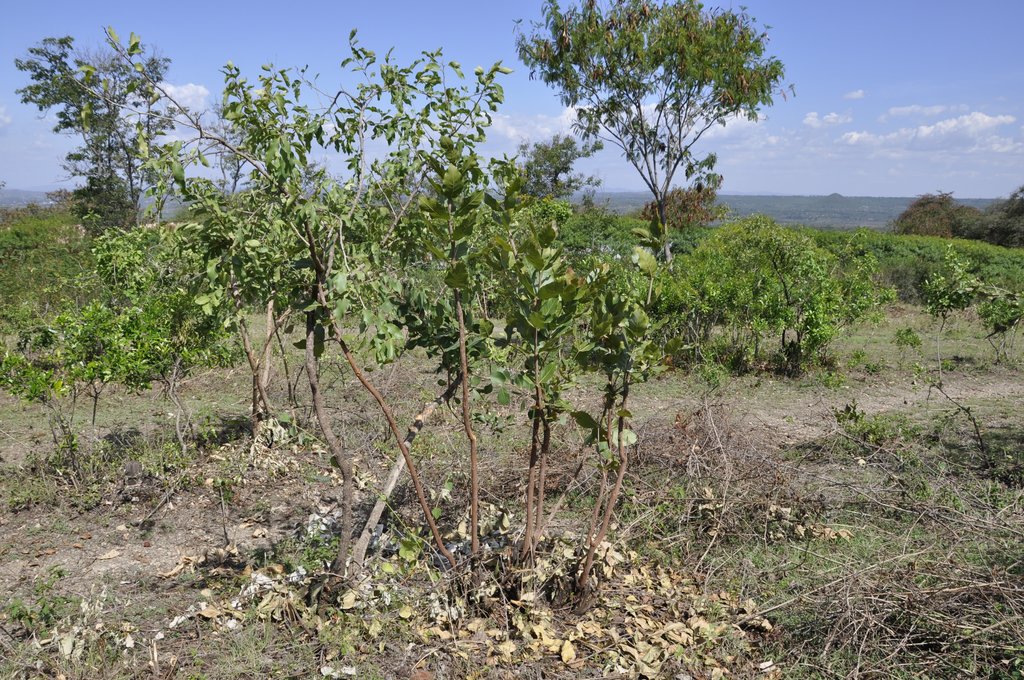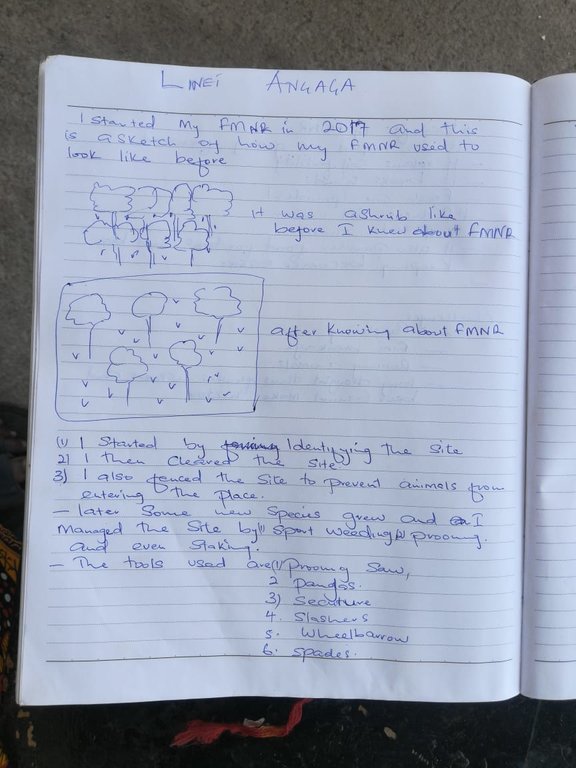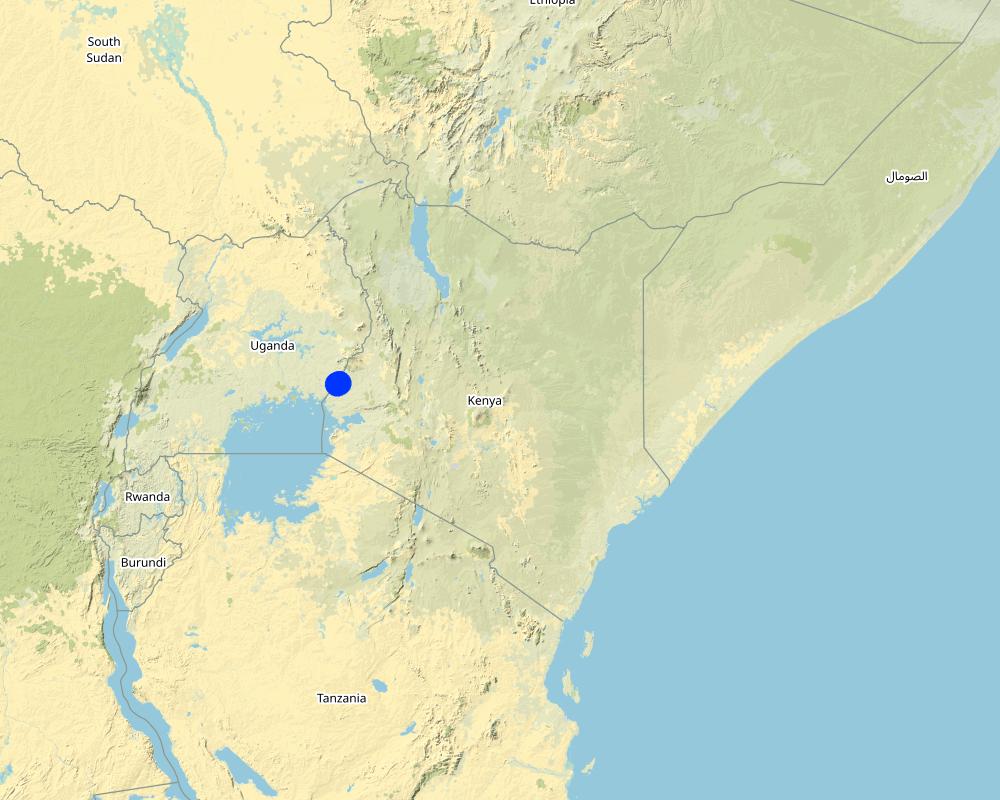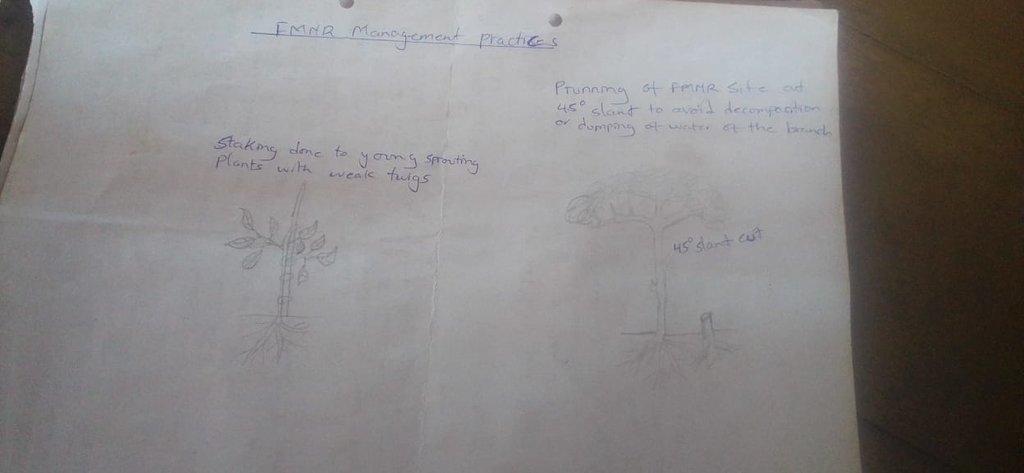Farmer managed natural regeneration in smallholdings [เคนยา]
- ผู้สร้างสรรค์:
- การอัพเดท:
- ผู้รวบรวม: Grace Koech
- ผู้เรียบเรียง: –
- ผู้ตรวจสอบ: William Critchley, Rima Mekdaschi Studer
FMNR
technologies_6600 - เคนยา
ดูส่วนย่อย
ขยายทั้งหมด ย่อทั้งหมด1. ข้อมูลทั่วไป
1.2 รายละเอียดที่ติดต่อได้ของผู้รวบรวมและองค์กรที่เกี่ยวข้องในการประเมินและการจัดเตรียมทำเอกสารของเทคโนโลยี
วิทยากรหลัก
ผู้ใช้ที่ดิน:
Sabina Atieno
lead farmer
เคนยา
ชื่อของโครงการซึ่งอำนวยความสะดวกในการทำเอกสารหรือการประเมินเทคโนโลยี (ถ้าเกี่ยวข้อง)
Reversing land degradation in Africa by scaling-up Evergreen Agriculture (Regreening Africa)ชื่อขององค์กรซึ่งอำนวยความสะดวกในการทำเอกสารหรือการประเมินเทคโนโลยี (ถ้าเกี่ยวข้อง)
International Centre for Research in Agroforestry (ICRAF) - เคนยา1.3 เงื่อนไขการใช้ข้อมูลที่ได้บันทึกผ่านทาง WOCAT
ผู้รวบรวมและวิทยากรหลักยอมรับเงื่อนไขเกี่ยวกับการใช้ข้อมูลที่ถูกบันทึกผ่านทาง WOCAT:
ใช่
1.4 การเปิดเผยเรื่องความยั่งยืนของเทคโนโลยีที่ได้อธิบายไว้
เทคโนโลยีที่ได้อธิบายไว้นี้เป็นปัญหาของความเสื่อมโทรมโทรมของที่ดินหรือไม่ จึงไม่ได้รับการยอมรับว่าเป็นเทคโนโลยีเพื่อการจัดการที่ดินอย่างยั่งยืน:
ไม่ใช่
แสดงความคิดเห็น:
FMNR has been embraced by the local community as they consider it low cost and products from FMNR are utilized for various livelihood activities such as woodfuel for household use and surplus for sale, beekeeping is practiced within the plots: passion fruits are integrated also - climbing on frameworks of prunings.
2. การอธิบายลักษณะของเทคโนโลยี SLM
2.1 การอธิบายแบบสั้น ๆ ของเทคโนโลยี
คำจำกัดความของเทคโนโลยี:
Farmer managed natural regeneration (FMNR) has been embraced by the local community as they consider it a low cost method of establishing agroforestry, and products are utilized for various livelihood activities such as woodfuel for household use and surplus for sale, beekeeping is practiced within the plots: passion fruits are integrated also - climbing on frameworks of prunings.
2.2 การอธิบายแบบละเอียดของเทคโนโลยี
คำอธิบาย:
Farmer managed natural regeneration (FMNR) involves helping naturally regenerating trees to grow at the homestead - in cropland or within enclosure. FMNR begins with assessment of the land to ascertain the potential to practice the technology. Plots that have shrubs or stumps are selected. Management by thinning is practiced to provide a suitable density to allow prolific growth. The offcuts and twigs from clearing the shrub can be used as mulch, stakes for beans or passion fruits, or as wood fuel. Other techniques used includes propping to support weak stems and protection of site to avoid interference by human and livestock. In Homabay county, Western Kenya, farmer manage their plots by thinning, supporting stems and pruning. Species are regenerated using protection of naturally seeded trees, including Acacia spp, Grewia bicolor, Balanities aegyptiaca, Psidium guajava, Combretum collinum, Markamia lutea, Thevetia peruviana, Albizia coriara and Rhus spp. FMNR has been embraced by the local community as they consider it a low cost way of establishing agroforestry and products are utilized for various livelihood activities such as woodfuel for household use and surplus for sale, beekeeping is practiced within the plots: passion fruits are integrated also - climbing on frameworks of prunings.
2.3 รูปภาพของเทคโนโลยี
2.4 วีดีโอของเทคโนโลยี
ความคิดเห็น/อธิบายสั้นๆ:
we can only get the youtube link to the video
https://youtube.com/clip/Ugkxk1nImuwSZVktgpAkvKwotlFKDo7s6_-8
วันที่:
14/12/2022
สถานที่:
Migori
ชื่อผู้ถ่ายวีดีโอ:
@manathaproductions
2.5 ประเทศภูมิภาค หรือสถานที่ตั้งที่เทคโนโลยีได้นำไปใช้และได้รับการครอบคลุมโดยการประเมินนี้
ประเทศ:
เคนยา
ภูมิภาค/รัฐ/จังหวัด:
Homabay and Migori counties
ระบุการกระจายตัวของเทคโนโลยี:
- กระจายไปอย่างสม่ำเสมอในพื้นที่
If precise area is not known, indicate approximate area covered:
- 1-10 ตร.กม.
Is/are the technology site(s) located in a permanently protected area?
ไม่ใช่
Map
×2.6 วันที่การดำเนินการ
ระบุปีที่ใช้:
2018
ถ้าไม่รู้ปีที่แน่นอน ให้ระบุวันที่โดยประมาณ:
- น้อยกว่า 10 ปี (ไม่นานนี้)
2.7 คำแนะนำของเทคโนโลยี
ให้ระบุว่าเทคโนโลยีถูกแนะนำเข้ามาอย่างไร:
- ด้วยการริเริ่มของผู้ใช้ที่ดินเอง
- เป็นส่วนหนึ่งของระบบแบบดั้งเดิมที่ทำก้นอยู่ (> 50 ปี)
- ทางโครงการหรือจากภายนอก
ความคิดเห็น (ประเภทของโครงการ เป็นต้น) :
Regreening project or project on restoration of degraded landscape combined with traditional agroforestry.
3. การจัดประเภทของเทคโนโลยี SLM
3.1 วัตถุประสงค์หลักของเทคโนโลยี
- ปรับปรุงการผลิตให้ดีขึ้น
- ลด ป้องกัน ฟื้นฟู การเสื่อมโทรมของที่ดิน
- อนุรักษ์ระบบนิเวศน์
- ปรับตัวเข้ากับการเปลี่ยนแปลงภูมิอากาศของโลก สภาพภูมิอากาศที่รุนแรงและผลกระทบ
- สร้างผลกระทบทางด้านเศรษฐกิจที่เป็นประโยชน์
3.2 ประเภทของการใช้ที่ดินในปัจจุบันที่ได้นำเทคโนโลยีไปใช้
Land use mixed within the same land unit:
ใช่
Specify mixed land use (crops/ grazing/ trees):
- การปลูกพืชร่วมกับปศุสัตว์และการทำป่าไม้ (Agro-silvopastoralism)

พื้นที่ปลูกพืช
- การปลูกพืชล้มลุกอายุปีเดียว
- การปลูกพืชยืนต้นที่ไม่มีเนื้อไม้
- การปลูกไม้ยืนต้น ไม้พุ่ม
Annual cropping - Specify crops:
- cereals - maize
- cereals - millet
- cereals - sorghum
- legumes and pulses - beans
- medicinal/ aromatic/ pesticidal plants and herbs
Annual cropping system:
Cassava/potato/manioc - maize/sorghum/millet
Perennial (non-woody) cropping - Specify crops:
- banana/plantain/abaca
- fodder crops - legumes, clover
- natural grasses
Tree and shrub cropping - Specify crops:
- avocado
- citrus
- fodder trees (Calliandra, Leucaena leucocephala, Prosopis, etc.)
- fruits, other
จำนวนของฤดูเพาะปลูกต่อปี:
- 2
ระบุ:
March to May, October to December
Is intercropping practiced?
ใช่
If yes, specify which crops are intercropped:
Maize and beans
sweet potatoes and vegetables
groundnuts, indigenous vegetables and cassava
Is crop rotation practiced?
ไม่ใช่

ทุ่งหญ้าเลี้ยงสัตว์
ทุ่งหญ้าเลี้ยงสัตว์ที่มีการจัดการแบบเข้มข้นหรือการผลิตอาหารสัตว์:
- ตัดแล้วขนไป / ไม่มีการปล่อยแทะเล็มเอง (Cut-and-carry / zero grazing)
- ทุ่งหญ้าเลี้ยงสัตว์ที่ได้มีการปรับปรุง (Improved pastures)
Animal type:
- beekeeping, apiculture
- cattle - dairy and beef (e.g. zebu)
- fish
- goats
- poultry
- sheep
Is integrated crop-livestock management practiced?
ใช่
ถ้าใช่ ระบุ:
Farmers utilize animal manure for soil amendment, the systems provide a buffer incase of crop failure
ผลิตภัณฑ์และบริการ:
- economic security, investment prestige
- eggs
- manure as fertilizer/ energy production
- meat
- milk
Species:
beekeeping, apiculture
Count:
5
Species:
cattle - dairy and beef (e.g. zebu)
Count:
4
Species:
fish
Count:
10
Species:
goats
Count:
4
Species:
poultry
Count:
10
แสดงความคิดเห็น:
FMNR is practiced on cropping field where farmers encourage naturally growing trees of high value to regenerate alongside the crops. within the grazing field, pruning and thinning of naturally regenerating trees is done to allow grass to grow. in some cases the grazing field are enclosed and farmers can only cut and carry the grasses especially when the trees/ seedlings are young.
3.3 Has land use changed due to the implementation of the Technology?
Has land use changed due to the implementation of the Technology?
- No (Continue with question 3.4)
Land use mixed within the same land unit:
ใช่
Specify mixed land use (crops/ grazing/ trees):
- การปลูกพืชร่วมกับปศุสัตว์และการทำป่าไม้ (Agro-silvopastoralism)

พื้นที่ปลูกพืช
- การปลูกพืชล้มลุกอายุปีเดียว
Annual cropping - Specify crops:
- cereals - maize
Is intercropping practiced?
ใช่
If yes, specify which crops are intercropped:
Maize, beans
Is crop rotation practiced?
ไม่ใช่
แสดงความคิดเห็น:
The land is used in the same way before and after the technology, the difference is the productivity of the land that has improved as a result of implementation of the technology. for example with increased availability of forage, farmers have witnessed milk production that translate to more food for the household and surplus for market that also support other livelihoods such as access to quality seedlings.
3.4 การใช้น้ำ
การใช้น้ำของที่ดินที่มีการใช้เทคโนโลยีอยู่:
- จากน้ำฝน
แสดงความคิดเห็น:
Most farmers do not irrigate the trees that regenerate naturally, they are mainly rain-fed systems.
3.5 กลุ่ม SLM ที่ตรงกับเทคโนโลยีนี้
- การปลูกป่าร่วมกับพืช
3.6 มาตรการ SLM ที่ประกอบกันเป็นเทคโนโลยี

มาตรการจัดการพืช
- A1: พืช/สิ่งปกคลุมดิน

มาตรการอนุรักษ์ด้วยวิธีพืช
- V1: ต้นไม้และพุ่มไม้คลุมดิน
- V2: หญ้าและไม้ยืนต้น
- V4: การแทนที่หรือการนำพันธุ์ต่างถิ่น/ที่รุกล้ำเข้ามา ออกไปจากพื้นที่

มาตรการอนุรักษ์ด้วยโครงสร้าง
- S1: คันดิน
- S2: ทำนบ เขื่อนดิน
- S10: มาตรการในการประหยัดพลังงาน

มาตรการอนุรักษ์ด้วยการจัดการ
- M2: การเปลี่ยนแปลงของการจัดการหรือระดับความเข้มข้น
- M3: การวางผังตามสิ่งแวดล้อมทางธรรมชาติและสิ่งแวดล้อมของมนุษย์
แสดงความคิดเห็น:
The choice of the measure depends on the level of degradation. in severely degraded areas a combination of measures are integrated.
3.7 รูปแบบหลักของการเสื่อมโทรมของที่ดินที่ได้รับการแก้ไขโดยเทคโนโลยี

การกัดกร่อนของดินโดยน้ำ
- Wt (Loss of topsoil): การสูญเสียดินชั้นบนหรือการกัดกร่อนที่ผิวดิน
- Wg (Gully erosion): การกัดกร่อนแบบร่องธารหรือการทำให้เกิดร่องน้ำเซาะ

การกัดกร่อนของดินโดยลม
- Et (Loss of topsoil): การสูญเสียดินชั้นบน

การเสื่อมโทรมของดินทางด้านเคมี
- Cn (Fertility decline): ความอุดมสมบูรณ์และปริมาณอินทรียวัตถุในดินถูกทำให้ลดลงไป (ไม่ได้เกิดจากสาเหตุการกัดกร่อน)

การเสื่อมโทรมของดินทางด้านกายภาพ
- Ps (Subsidence of organic soils): การยุบตัวของดินอินทรีย์ การทรุดตัวของดิน

การเสื่อมโทรมของดินทางด้านชีวภาพ
- Bc (Reduction of vegetation cover): การลดลงของจำนวนพืชที่ปกคลุมดิน
- Bh (Loss of habitat): การสูญเสียแหล่งที่อยู่
- Bq (Quantity/biomass decline): การลดลงของปริมาณหรือมวลชีวภาพ
- Bs (Quality and species composition): องค์ประกอบหรือความหลากหลายทางคุณภาพและชนิดพันธุ์ลดลง
- Bl (Loss of soil life): การสูญเสียสิ่งมีชีวิตในดิน

การเสื่อมโทรมของน้ำ
- Ha (Aridification): การเกิดความแห้งแล้ง
- Hs (Change in quantity of surface water): การเปลี่ยนแปลงปริมาณของน้ำที่ผิวดิน
- Hg (Change in groundwater): การเปลี่ยนแปลงของน้ำบาดาลหรือระดับน้ำในแอ่งน้ำบาดาล
แสดงความคิดเห็น:
Another form of degradation managed using the technology is invasive species management by thinning out unwanted species or uprooting.
3.8 การป้องกัน การลดลง หรือการฟื้นฟูความเสื่อมโทรมของที่ดิน
ระบุเป้าหมายของเทคโนโลยีกับความเสื่อมโทรมของที่ดิน:
- ฟื้นฟูบำบัดที่ดินที่เสื่อมโทรมลงอย่างมาก
- ปรับตัวกับสภาพความเสื่อมโทรมของที่ดิน
แสดงความคิดเห็น:
The technology is promoted to reverse effects of land degradation and adapt to changing patterns as a result of the degradation. for example the area enclosure is able to regenerate within the prevailing environmental conditions.
4. ข้อมูลจำเพาะด้านเทคนิค กิจกรรมการนำไปปฏิบัติใช้ ปัจจัยนำเข้า และค่าใช้จ่าย
4.1 แบบแปลนทางเทคนิคของเทคโนโลยี
ข้อมูลจำเพาะด้านเทคนิค (แบบแปลนทางเทคนิคของเทคโนโลยี):
The height of the seedlings to be regenerated ranges from as low as ground level to fully grown trees, the spacing between the trees is 10m apart in crop land and 5m in grazing field. .
ผู้เขียน:
William Gumbo, farmer Homabay county
วันที่:
03/04/2023
4.2 ข้อมูลทั่วไปเกี่ยวกับการคำนวณปัจจัยนำเข้าและค่าใช้จ่าย
ให้ระบุว่าค่าใช้จ่ายและปัจจัยนำเข้าได้รับการคำนวณอย่างไร:
- ต่อพื้นที่ที่ใช้เทคโนโลยี
ระบุขนาดและหน่วยพื้นที่:
1 acre
If using a local area unit, indicate conversion factor to one hectare (e.g. 1 ha = 2.47 acres): 1 ha =:
0.4 ha
ระบุสกุลเงินที่ใช้คำนวณค่าใช้จ่าย:
- USD
ระบุค่าเฉลี่ยของค่าจ้างในการจ้างแรงงานต่อวัน:
$3
4.3 กิจกรรมเพื่อการจัดตั้ง
| กิจกรรม | Timing (season) | |
|---|---|---|
| 1. | Survey land | dry season |
| 2. | Take an inventory of available species and their priority uses | dry season |
| 3. | generate a priority use list for the farm | dry season |
| 4. | generate a preferred species list | dry season |
| 5. | Mark and remove the unwanted species | dry season |
| 6. | select species and stumps to be regenerated | dry season |
| 7. | manage the stumps/stems by removing unwated stumps,thinning to remain with manageable density | dry season |
| 8. | keep three to five stems on each of the selected species and stumps | onset of the rain season |
| 9. | Manage the selected by pruning ofside branches, protection by fencing, utilize the prunning and coppices as firewood, make biochar, stakes for vegetable farming, compost making, construction work etc | raining season |
| 10. | allow the trees to grow for preferred use, periodically pruning is required | 2-6 months |
แสดงความคิดเห็น:
Where the trees regenerated has low density or diversity or the high value/preferred species are not available consider enrichment planting. in areas where FMNR is not feasible resort to enrichment planting. other technologies such as grass reseeding, soil water conservation could be implemented alongside FMNR.
4.4 ค่าใช้จ่ายของปัจจัยนำเข้าที่จำเป็นสำหรับการจัดตั้ง
| ปัจจัยนำเข้า | หน่วย | ปริมาณ | ค่าใช้จ่ายต่อหน่วย | ค่าใช้จ่ายทั้งหมดต่อปัจจัยนำเข้า | %ของค่าใช้จ่ายที่ก่อให้เกิดขึ้นโดยผู้ใช้ที่ดิน | |
|---|---|---|---|---|---|---|
| แรงงาน | Land survey and inventory of species | person day | 1.0 | 3.0 | 3.0 | 100.0 |
| แรงงาน | marking and removing unwanted species | person day | 1.0 | 3.0 | 3.0 | 100.0 |
| แรงงาน | marking and regenerating the preferred species | person day | 3.0 | 3.0 | 9.0 | 100.0 |
| แรงงาน | managing regenerated trees | person day | 1.0 | 3.0 | 3.0 | 100.0 |
| อุปกรณ์ | machete | 100.0 | ||||
| อุปกรณ์ | axe | 100.0 | ||||
| อุปกรณ์ | file | 100.0 | ||||
| อุปกรณ์ | fork hoe | 100.0 | ||||
| อุปกรณ์ | hoe | 100.0 | ||||
| อุปกรณ์ | wheelbarrow | 100.0 | ||||
| อุปกรณ์ | rake | 100.0 | ||||
| อุปกรณ์ | pruning saw | 100.0 | ||||
| วัสดุสำหรับก่อสร้าง | use locally available, dead fence | |||||
| ค่าใช้จ่ายทั้งหมดของการจัดตั้งเทคโนโลยี | 18.0 | |||||
| Total costs for establishment of the Technology in USD | 18.0 | |||||
แสดงความคิดเห็น:
Where the farmer decide to do enrichment planting, permanent fencing, grass reseeding the cost is higher that what is projected here. the cost for the first year is high, subsequent years the cost is low. The household use available equipment to manage and regenerate the trees.
4.5 การบำรุงรักษาสภาพหรือกิจกรรมที่เกิดขึ้นเป็นประจำ
| กิจกรรม | ช่วงระยะเวลา/ความถี่ | |
|---|---|---|
| 1. | pruning and removal of emerging species | twice per year |
แสดงความคิดเห็น:
Maintenance depend on the availability of rainfall that determine how faster the trees establishes.
4.6 ค่าใช้จ่ายของปัจจัยนำเข้าและกิจกรรมที่เกิดขึ้นเป็นประจำที่ต้องการการบำรุงรักษา (ต่อปี)
| ปัจจัยนำเข้า | หน่วย | ปริมาณ | ค่าใช้จ่ายต่อหน่วย | ค่าใช้จ่ายทั้งหมดต่อปัจจัยนำเข้า | %ของค่าใช้จ่ายที่ก่อให้เกิดขึ้นโดยผู้ใช้ที่ดิน | |
|---|---|---|---|---|---|---|
| แรงงาน | pruning and removing unwanted | 1 | 1.0 | 3.0 | 3.0 | 100.0 |
| ค่าใช้จ่ายทั้งหมดของการบำรุงรักษาสภาพเทคโนโลยี | 3.0 | |||||
| Total costs for maintenance of the Technology in USD | 3.0 | |||||
แสดงความคิดเห็น:
Maintenance cost is lower since it is done periodically and trees establishes at different growth rates.
4.7 ปัจจัยสำคัญที่สุดที่มีผลกระทบต่อค่าใช้จ่าย
ปัจจัยสำคัญที่สุดที่มีผลกระทบต่อค่าใช้จ่ายต่างๆ:
1) density of the species
2) frequency and intensity of the rains
3) level of degradation
4) management objectives
5. สิ่งแวดล้อมทางธรรมชาติและของมนุษย์
5.1 ภูมิอากาศ
ฝนประจำปี
- < 250 ม.ม.
- 251-500 ม.ม.
- 501-750 ม.ม.
- 751-1,000 ม.ม.
- 1,001-1,500 ม.ม.
- 1,501-2,000 ม.ม.
- 2,001-3,000 ม.ม.
- 3,001-4,000 ม.ม.
- > 4,000 ม.ม.
เขตภูมิอากาศเกษตร
- กึ่งชุ่มชื้น
FMNR is mainly a dry land practice but can also be practiced on humid areas where existing trees are managed by pruning and thinning to manage density.
5.2 สภาพภูมิประเทศ
ค่าเฉลี่ยความลาดชัน:
- ราบเรียบ (0-2%)
- ลาดที่ไม่ชัน (3-5%)
- ปานกลาง (6-10%)
- เป็นลูกคลื่น (11-15%)
- เป็นเนิน (16-30%)
- ชัน (31-60%)
- ชันมาก (>60%)
ธรณีสัณฐาน:
- ที่ราบสูง/ที่ราบ
- สันเขา
- ไหล่เขา
- ไหล่เนินเขา
- ตีนเนิน
- หุบเขา
ระดับความสูง:
- 0-100 เมตร
- 101-500 เมตร
- 501-1,000 เมตร
- 1,001-1,500 เมตร
- 1,501-2,000 เมตร
- 2,001-2,500 เมตร
- 2,501-3,000 เมตร
- 3,001-4,000 เมตร
- > 4,000 เมตร
ให้ระบุถ้าเทคโนโลยีได้ถูกนำไปใช้:
- ไม่เกี่ยวข้อง
ความคิดเห็นและข้อมูลจำเพาะเพิ่มเติมเรื่องสภาพภูมิประเทศ:
Topography has no effect on FMNR
5.3 ดิน
ค่าเฉลี่ยความลึกของดิน:
- ตื้นมาก (0-20 ซ.ม.)
- ตื้น (21-50 ซ.ม.)
- ลึกปานกลาง (51-80 ซ.ม.)
- ลึก (81-120 ซ.ม.)
- ลึกมาก (>120 ซ.ม.)
เนื้อดิน (ดินชั้นบน):
- หยาบ/เบา (ดินทราย)
- ปานกลาง (ดินร่วน ทรายแป้ง)
เนื้อดินล่าง (> 20 ซ.ม.ต่ำจากผิวดิน):
- หยาบ/เบา (ดินทราย)
- ปานกลาง (ดินร่วน ทรายแป้ง)
อินทรียวัตถุในดิน:
- ปานกลาง (1-3%)
- ต่ำ (<1%)
(ถ้ามี) ให้แนบคำอธิบายเรื่องดินแบบเต็มหรือระบุข้อมูลที่มีอยู่ เช่น ชนิดของดิน ค่า pH ของดินหรือความเป็นกรดของดิน ความสามารถในการแลกเปลี่ยนประจุบวก ไนโตรเจน ความเค็ม เป็นต้น:
Soil information is not available
5.4 ความเป็นประโยชน์และคุณภาพของน้ำ
ระดับน้ำใต้ดิน:
5-50 เมตร
น้ำไหลบ่าที่ผิวดิน:
ปานกลาง
คุณภาพน้ำ (ที่ยังไม่ได้บำบัด):
เป็นน้ำเพื่อการดื่มที่ดี
Water quality refers to:
both ground and surface water
ความเค็มของน้ำเป็นปัญหาหรือไม่:
ไม่ใช่
กำลังเกิดน้ำท่วมในพื้นที่หรือไม่:
ไม่ใช่
ความคิดเห็นและข้อมูลจำเพาะเพิ่มเติมเรื่องคุณภาพและปริมาณน้ำ:
FMNR rely on natural environmental conditions
5.5 ความหลากหลายทางชีวภาพ
ความหลากหลายทางชนิดพันธุ์:
- ปานกลาง
ความหลากหลายของแหล่งที่อยู่:
- ปานกลาง
ความคิดเห็นและข้อมูลจำเพาะเพิ่มเติมของความหลากหลายทางชีวภาพ:
Agrobiodiversity increases with FMNR/ Agroforestry
5.6 ลักษณะของผู้ใช้ที่ดินที่นำเทคโนโลยีไปปฏิบัติใช้
อยู่กับที่หรือเร่ร่อน:
- อยู่กับที่
แนวทางการตลาดของระบบการผลิต:
- mixed (subsistence/ commercial)
รายได้ที่มาจากนอกฟาร์ม:
- 10-50% ของรายได้ทั้งหมด
ระดับของความมั่งคั่งโดยเปรียบเทียบ:
- พอมีพอกิน
เป็นรายบุคคล/ครัวเรือน:
- เป็นรายบุคคล/ครัวเรือน
- กลุ่ม/ชุมชน
ระดับของการใช้เครื่องจักรกล:
- งานที่ใช้แรงกาย
- การใช้กำลังจากสัตว์
เพศ:
- หญิง
- ชาย
อายุของผู้ใช้ที่ดิน:
- ผู้เยาว์
- วัยกลางคน
5.7 Average area of land used by land users applying the Technology
- < 0.5 เฮกตาร์
- 0.5-1 เฮกตาร์
- 1-2 เฮกตาร์
- 2-5 เฮกตาร์
- 5-15 เฮกตาร์
- 15-50 เฮกตาร์
- 50-100 เฮกตาร์
- 100-500 เฮกตาร์
- 500-1,000 เฮกตาร์
- 1,000-10,000 เฮกตาร์
- >10,000 เฮกตาร์
พิจารณาว่าเป็นขนาดเล็ก กลาง หรือขนาดใหญ่ (ซึ่งอ้างอิงถึงบริบทระดับท้องถิ่น):
- ขนาดเล็ก
- ขนาดกลาง
5.8 กรรมสิทธิ์ในที่ดิน สิทธิในการใช้ที่ดินและสิทธิในการใช้น้ำ
กรรมสิทธิ์ในที่ดิน:
- เป็นแบบชุมชนหรือหมู่บ้าน
- รายบุคคล ได้รับสิทธิครอบครอง
สิทธิในการใช้ที่ดิน:
- เกี่ยวกับชุมชน (ถูกจัดระเบียบ)
- รายบุคคล
สิทธิในการใช้น้ำ:
- เกี่ยวกับชุมชน (ถูกจัดระเบียบ)
- รายบุคคล
Are land use rights based on a traditional legal system?
ใช่
5.9 การเข้าถึงบริการและโครงสร้างพื้นฐาน
สุขภาพ:
- จน
- ปานกลาง
- ดี
การศึกษา:
- จน
- ปานกลาง
- ดี
ความช่วยเหลือทางด้านเทคนิค:
- จน
- ปานกลาง
- ดี
การจ้างงาน (เช่น ภายนอกฟาร์ม):
- จน
- ปานกลาง
- ดี
ตลาด:
- จน
- ปานกลาง
- ดี
พลังงาน:
- จน
- ปานกลาง
- ดี
ถนนและการขนส่ง:
- จน
- ปานกลาง
- ดี
น้ำดื่มและการสุขาภิบาล:
- จน
- ปานกลาง
- ดี
บริการด้านการเงิน:
- จน
- ปานกลาง
- ดี
6. ผลกระทบและสรุปคำบอกกล่าว
6.1 ผลกระทบในพื้นที่ดำเนินการ (On-site) จากการใช้เทคโนโลยี
ผลกระทบทางด้านเศรษฐกิจและสังคม
การผลิต
การผลิตพืชผล
การผลิตพืชที่ใช้เลี้ยงปศุสัตว์
การผลิตไม้
คุณภาพป่า /พื้นที่ทำไม้
การผลิตของจากป่าทุกชนิดยกเว้นไม้
การเสี่ยงต่อความล้มเหลวในการผลิต
ความหลากหลายของผลิตภัณฑ์
พื้นที่สำหรับการผลิต
การจัดการที่ดิน
การผลิตพลังงาน
แสดงความคิดเห็น/ระบุ:
well managed FMNR farms in Migori and Homabay increase availability of timber and non timber products on farms.
ความเป็นประโยชน์และคุณภาพของน้ำ
การมีน้ำดื่มไว้ให้ใช้
คุณภาพน้ำดื่ม
การมีน้ำไว้ให้ปศุสัตว์
แสดงความคิดเห็น/ระบุ:
effect of FMNR on water resources indicated increase as shown within the nyatike mirema hills where over time rivers that had disappeared are restore and water access increased in the area. similarly Homabay has received increased rainfall as compared to previous years due to increased tree cover with trees of varying growth heights.
คุณภาพน้ำสำหรับปศุสัตว์
การมีน้ำไว้ให้สำหรับการชลประทาน
คุณภาพน้ำสำหรับการชลประทาน
ความต้องการน้ำจากการชลประทาน
รายได้และค่าใช้จ่าย
ค่าใช่จ่ายของปัจจัยการผลิตทางการเกษตร
รายได้จากฟาร์ม
แสดงความคิดเห็น/ระบุ:
Business such as beekeeping and firewood bulking is practised within the FMNR plots generating additional income for the homestead.
ความหลากหลายของแหล่งผลิตรายได้
แสดงความคิดเห็น/ระบุ:
increased, FMNR based enterprises developed for example beekeeping, firewood
ความเหลื่อมล้ำทางเศรษฐกิจ
แสดงความคิดเห็น/ระบุ:
data not documented
ภาระงาน
แสดงความคิดเห็น/ระบุ:
time to access firewood which is the main economic activity in the area due to reliance of it for cooking is saved as pruning from the plot serve this purpose and surplus sold hence more time for other livelihood activities.
ผลกระทบด้านสังคมวัฒนธรรมอื่น ๆ
ความมั่นคงด้านอาหาร / พึ่งตนเองได้
แสดงความคิดเห็น/ระบุ:
some plots are managed communally, this bring people together to exchange ideas and conversation as they working together on the plots building the social cohesion within the community, additionally, community receive more people visiting their sites to learn more about the practice which comes with some prestige for the community.
สถานการณ์ด้านสุขภาพ
แสดงความคิดเห็น/ระบุ:
improved due to access to more products and income increasing purchasing power of the community.
การใช้ที่ดิน / สิทธิในการใช้น้ำ
แสดงความคิดเห็น/ระบุ:
land and water rights applies to all community members
โอกาสทางวัฒนธรรม
แสดงความคิดเห็น/ระบุ:
FMNR practice bring people together that present many opportunities to interact and promote collective action.
โอกาสทางด้านสันทนาการ
แสดงความคิดเห็น/ระบุ:
increased as people are visiting the demo farms
สถาบันของชุมชน
แสดงความคิดเห็น/ระบุ:
strengthened communities formed groups to enable them work together to better their community, access financial support and market their products jointly
สถาบันแห่งชาติ
แสดงความคิดเห็น/ระบุ:
FMNR practises links different actors together during trainings, field days and demonstration on practise. This approach has contributed to increased knowledge and skills and interaction between the local and national institutions.
SLM หรือความรู้เรื่องความเสื่อมโทรมของที่ดิน
แสดงความคิดเห็น/ระบุ:
knowledge products on FMNR practice in Kenya developed, training materials prepared, several trainings conducted on FMNR.
การบรรเทาความขัดแย้ง
แสดงความคิดเห็น/ระบุ:
N/A
สถานการณ์ของกลุ่มด้อยโอกาส ทางด้านสังคมและเศรษฐกิจ
แสดงความคิดเห็น/ระบุ:
N/A
ผลกระทบด้านนิเวศวิทยา
วัฐจักรน้ำหรือน้ำบ่า
ปริมาณน้ำ
แสดงความคิดเห็น/ระบุ:
restoration of water sources due increased ground water as a result of restoration
คุณภาพน้ำ
แสดงความคิดเห็น/ระบุ:
N/A
การเก็บเกี่ยวหรือการกักเก็บน้ำ
แสดงความคิดเห็น/ระบุ:
more water accessed due to increased volumes of water due to more rains
น้ำไหลบ่าที่ผิวดิน
แสดงความคิดเห็น/ระบุ:
increased vegetation cover reduce surface flow in the intervention areas
การระบายน้ำส่วนเกิน
แสดงความคิดเห็น/ระบุ:
N/A
น้ำบาดาลหรือระดับน้ำในแอ่งน้ำบาดาล
แสดงความคิดเห็น/ระบุ:
see above
การระเหย
แสดงความคิดเห็น/ระบุ:
higher water conservation
ดิน
ความชื้นในดิน
แสดงความคิดเห็น/ระบุ:
more water infiltrate to soil and stored at the root zone
สิ่งปกคลุมดิน
แสดงความคิดเห็น/ระบุ:
more cover crops, foliage from leaf fall increases soil cover
การสูญเสียดิน
แสดงความคิดเห็น/ระบุ:
soil is not exposed for ease of erosion
การสะสมของดิน
แสดงความคิดเห็น/ระบุ:
N/A
การเกิดแผ่นแข็งที่ผิวดิน /การเกิดชั้นดาน
แสดงความคิดเห็น/ระบุ:
N/A
การอัดแน่นของดิน
แสดงความคิดเห็น/ระบุ:
N/A
การหมุนเวียนและการเติมของธาตุอาหาร
แสดงความคิดเห็น/ระบุ:
with increased water availability, reduced soil temperature nutrient cycling increased
ความเค็ม
แสดงความคิดเห็น/ระบุ:
N/A
อินทรียวัตถุในดิน/ต่ำกว่าดินชั้น C
แสดงความคิดเห็น/ระบุ:
N/A
ความเป็นกรด
แสดงความคิดเห็น/ระบุ:
N/A
ความหลากหลายทางชีวภาพของพืชและสัตว์
การปกคลุมด้วยพืช
มวลชีวภาพ/เหนือดินชั้น C
แสดงความคิดเห็น/ระบุ:
N/A
ความหลากหลายทางชีวภาพของพืช
พืชพันธุ์ต่างถิ่นที่รุกล้ำเข้ามา
แสดงความคิดเห็น/ระบุ:
N/A
ความหลากหลายทางชีวภาพของสัตว์
แสดงความคิดเห็น/ระบุ:
N/A
ชนิดพันธุ์ที่ให้ประโยชน์
ความหลากหลายของสัตว์
การจัดการศัตรูพืชและโรคพืช
แสดงความคิดเห็น/ระบุ:
N/A
ลดความเสี่ยงของภัยพิบัติ
ผลกระทบจากน้ำท่วม
แสดงความคิดเห็น/ระบุ:
N/A
ดินถล่ม/ ซากต่าง ๆ ที่ถูกพัดพามา
แสดงความคิดเห็น/ระบุ:
N/A
ผลกระทบจากภัยแล้ง
ผลกระทบของพายุไซโคลน พายุฝน
แสดงความคิดเห็น/ระบุ:
N/A
การปล่อยคาร์บอนและก๊าซเรือนกระจก
แสดงความคิดเห็น/ระบุ:
N/A
ความเสี่ยงจากไฟ
ความเร็วของลม
ภูมิอากาศจุลภาค
Specify assessment of on-site impacts (measurements):
FMNR increases diversity on-site. Issues of water, carbon, soil were not assessed in the study.
6.2 ผลกระทบนอกพื้นที่ดำเนินการ (Off-site) จากการใช้เทคโนโลยี
Specify assessment of off-site impacts (measurements):
Offsite benefits of FMNR were not assessed.
6.3 การเผชิญและความตอบสนองของเทคโนโลยีต่อการเปลี่ยนแปลงสภาพภูมิอากาศที่ค่อยเป็นค่อยไป และสภาพรุนแรงของภูมิอากาศ / ภัยพิบัติ (ที่รับรู้ได้โดยผู้ใช้ที่ดิน)
การเปลี่ยนแปลงสภาพภูมิอากาศที่ค่อยเป็นค่อยไป
การเปลี่ยนแปลงสภาพภูมิอากาศที่ค่อยเป็นค่อยไป
| ฤดู | increase or decrease | เทคโนโลยีมีวิธีการรับมืออย่างไร | |
|---|---|---|---|
| ฝนประจำปี | เพิ่มขึ้น | ดี |
แสดงความคิดเห็น:
land users are conversant to temperature and rainfall as the main climate related issues.
6.4 การวิเคราะห์ค่าใช้จ่ายและผลประโยชน์ที่ได้รับ
ผลประโยชน์ที่ได้รับเปรียบเทียบกับค่าใช้จ่ายในการจัดตั้งเป็นอย่างไร (จากมุมมองของผู้ใช้ที่ดิน)
ผลตอบแทนระยะสั้น:
ด้านบวกเล็กน้อย
ผลตอบแทนระยะยาว:
ด้านบวกอย่างมาก
ผลประโยชน์ที่ได้รับเปรียบเทียบกับค่าใช้จ่ายในการบำรุงรักษาหรือต้นทุนที่เกิดขึ้นซ้ำอีก เป็นอย่างไร (จากมุมมองของผู้ใช้ที่ดิน)
ผลตอบแทนระยะสั้น:
ด้านลบเล็กน้อย
ผลตอบแทนระยะยาว:
ด้านบวกอย่างมาก
6.5 การปรับตัวของเทคโนโลยี
- > 50%
Of all those who have adopted the Technology, how many did so spontaneously, i.e. without receiving any material incentives/ payments?
- 51-90%
6.6 การปรับตัว
เทคโนโลยีได้รับการปรับเปลี่ยนเมื่อเร็วๆนี้ เพื่อให้ปรับตัวเข้ากับสภาพที่กำลังเปลี่ยนแปลงหรือไม่:
ไม่ใช่
6.7 จุดแข็ง / ข้อได้เปรียบ / โอกาสของเทคโนโลยี
| จุดแข็ง / ข้อได้เปรียบ / โอกาสในทัศนคติของผู้ใช้ที่ดิน |
|---|
| user friendly and complementary to other land use activities |
| cost effective after the first investment |
| high potential for scaling |
| จุดแข็ง / ข้อได้เปรียบ / โอกาสในทัศนคติของผู้รวบรวมหรือวิทยากรหลัก |
|---|
| preserve biological diversity |
| start with the knowledge that farmers posses |
| build on the local knowledge of the farmers |
6.8 จุดอ่อน / ข้อเสียเปรียบ / ความเสี่ยงของเทคโนโลยีและวิธีการแก้ไข
| จุดอ่อน / ข้อเสียเปรียบ / ความเสี่ยงในทัศนคติของผู้ใช้ที่ดิน | มีวิธีการแก้ไขได้อย่างไร |
|---|---|
| high cost of initial investment | form farmer cooperatives to access credit |
| limited available natural regenerants | compliment with enrichment planting |
| sometimes available stumps are not the preferred species | compliment with enrichment planting |
| จุดอ่อน / ข้อเสียเปรียบ / ความเสี่ยงในทัศนคติของผู้รวบรวมหรือวิทยากรหลัก | มีวิธีการแก้ไขได้อย่างไร |
|---|---|
| FMNR policy missing | Support policy reforms to include FMNR |
| practiced mainly in the rangeland where land tenure is communal | Strengthening existing community structures |
| slow growing of the indigenous species making it less preferred by the farmers | compliment with fast growing high value trees |
7. การอ้างอิงและการเชื่อมต่อ
7.1 วิธีการและแหล่งข้อมูล
- ไปเยี่ยมชมภาคสนาม การสำรวจพื้นที่ภาคสนาม
9
- การเก็บรวบรวมมาจากรายงานและเอกสารที่มีอยู่
วันที่เก็บรวบรวมข้อมูล(ภาคสนาม) :
13/12/2022
7.2 การอ้างอิงถึงสิ่งตีพิมพ์
หัวข้อ, ผู้เขียน, ปี, หมายเลข ISBN:
10.Wanjira, E.O., Muriuki, J. & Ojuok, I. (2020). Farmer Managed Natural Regeneration for Kenya: A primer for development practitioners. Nairobi, Kenya: World Agroforestry (ICRAF), pg133. Erick Wanjira 1:02 PM 2.Muriuki J, Wanjira EO, Ojuok I. 2022.Farmer Managed Natural Regeneration in Kenya: A trainer’s guide for farmers, pastoralists and other land users. Nairobi: World Agroforestry (ICRAF), 56. 3.Obwocha E, Muriuki J, Wanjira EO, Mohamed A, Muse IM.2022. Farmer Managed Natural Regeneration in Somali context: Practitioners’ manual. Nairobi: World Agroforestry (ICRAF), p84 Erick Wanjira 1:03 PM Rinaudo, T., Muller, A. & Morris, M. (2019). Farmer Managed Natural Regeneration (FMNR) Manual. A resource for project managers, practitioners and all who are interested in better understanding and supporting the FMNR movement. World Vision Australia.
ชื่อเรื่อง ผู้เขียน ปี ISBN:
open access
7.3 Links to relevant online information
ชื่อเรื่องหรือคำอธิบาย:
10.Wanjira, E.O., Muriuki, J. & Ojuok, I. (2020). Farmer Managed Natural Regeneration for Kenya: A primer for development practitioners. Nairobi, Kenya: World Agroforestry (ICRAF), pg133. Erick Wanjira 1:02 PM 2.Muriuki J, Wanjira EO, Ojuok I. 2022.Farmer Managed Natural Regeneration in Kenya: A trainer’s guide for farmers, pastoralists and other land users. Nairobi: World Agroforestry (ICRAF), 56. 3.Obwocha E, Muriuki J, Wanjira EO, Mohamed A, Muse IM.2022. Farmer Managed Natural Regeneration in Somali context: Practitioners’ manual. Nairobi: World Agroforestry (ICRAF), p84 Erick Wanjira 1:03 PM Rinaudo, T., Muller, A. & Morris, M. (2019). Farmer Managed Natural Regeneration (FMNR) Manual. A resource for project managers, practitioners and all who are interested in better understanding and supporting the FMNR movement. World Vision Australia.
7.4 General comments
The team is available to provide additional information
ลิงก์และโมดูล
ขยายทั้งหมด ย่อทั้งหมดลิงก์
ไม่มีลิงก์
โมดูล
ไม่มีโมดูล


